Envis Centre, Ministry of Environment & Forest, Govt. of India
Printed Date: Tuesday, September 16, 2025
Fruits giving plants
Kerala is a green state and there are a wide variety of trees and plants. There are different species of trees and some of them are cultivated for fruits. Some of the main fruit giving trees of Kerala are mentioned here.
Plavu (Jack fruit tree)
Common Name: Plavu (Jack fruit tree)
Scientific Name:Artocarpus heterophyllus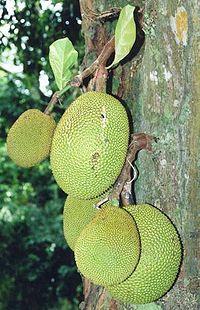
Jack fruit tree, is a large evergreen spreading tree known for the largest tree borne fruit in the world. Jack fruit tree is mostly seen in the tropical lowlands. This fruits is large and fleshy and are covered with thorny tubercles. Unripe fruits can be cooked. The seeds may be boiled or baked. Amongst a number of varieties of jackfruits, the honey-jack (muttan varikka or thaen varikka) is considered the sweetest and the best. The flesh is starchy and fibrous and provides energy. Jack fruit tree is used in the treatment of various diseases such as vitiated vata, pitta, diarrhea, skin disease, urinary retention and general weakness. The timber of the tree is used for making furniture as it is termite-proof. The core of the aged and seasoned jackfruit tree (Varikka plavu) is used to make the two feet body of the chenda. Ammachi plave, the name given to an old jackfruit tree in the Sree Krishna Swamy Temple at Neyyattinkara near Thiruvananthapuram, is legendarily connected with the time of Marthanda Varma, the founder of Modern Travancore. It is believed that the King escaped from his enemies by hiding in the huge hollow of the Ammachi Plavu.
Mavu (Mango tree)
Common Name: Mavu (Mango tree)
Scientific Name: Mangifera indica L.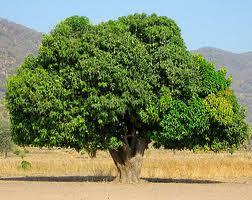
Mango, the king of fruits, is one of the most popular of the tropical fruit varieties. Mango has undergone considerable varietal differentiation. In India alone, over 100 named varieties are known. Apart from these, millions of seedling trees grow throughout the country, each of which has its own distinctive characteristics. A major portion of mango trees in Kerala are of seedling origin. Tender and mature but unripe mangoes are extensively used for making pickles and chutney. Ripe fruits are eaten as such. A variety of products are made out of this. They are canned mango slices, mango pulp, jam, juice, custard powder, ready to serve mango beverages, toffees etc.
Vazha
Common Name: Vazha
Scientific Name: Musa acuminate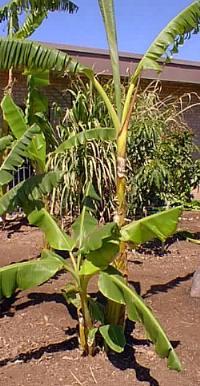
About 50-60 tonns of bananas is exported from Kerala every day. The popular varieties include palayankodan, sahasrapadali, ayiram poovan, poovan, nenthran, kumpillaannan, malayannan, thottannan, kadali, rasakadali (njaalipoovan), chenkadali (kappa), kaliyethan, chengali, aattunenthran, pachakkappa, robesta, matti, padatti, peyan, monthan, annan etc. Bananas have a variety of sizes and colours when ripe. The colours are yellow, purple and red. Ripe bananas are very sweet and they can be eaten raw whereas unripe can cooked and eaten. The banana plant’s trunk when peeled has a tender core which is edible when cooked. Similarly the flower is also used for delicious dishes. Banana leaves are often used as plates or disposable food containers where people consider it as a plate to have their food on this leaf. Taking banana helps to reduce the risk of colorectal cancer and breast cancer and renal cell carcinoma in women. Those who have latex allergy get reaction if banana is consumed.
Omaikka (Papaya)
Common Name: Omaikka (Papaya)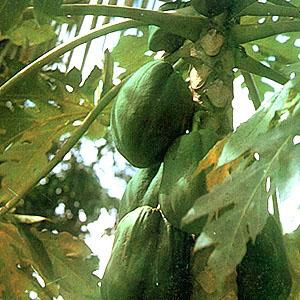
Scientific Name: Carica Papaya
The papaya is the fruit of the plant Carica papaya, in the genus Carica. It is a very large plant and has a single stem that grows to a height of around 5 to 10 meters tall. The leaves are seen only in the top of the trunk and are arranged in a spiral manner. The ripe fruit is eaten raw whereas the unripe fruit of papaya is cooked and eaten. They are used to make curries, salads and stews. It has high amount of pectin in it that can be used to make jellies. Some of the various uses of papaya are that it is used as a cooking aid, in medicine etc. Soup of tender papaya (boiled in water) or slices of unripe papaya is consumed to terminate unwanted pregnancy in the early stages of conceiving.
Seethaappazham (Custard Apple)
Common Name: Seethaappazham (Custard Apple)
Scientific Name: Annona squamosa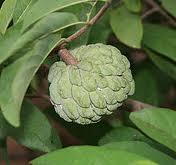
This is a small deciduous or semi evergreen tree which attains a height of about 10 metres. It is largely found in the tropical regions where the climate is humid and warm. The custard apple is a native of the West Indies and later it was taken to Southern Mexico. The fruits are variable in shape and are irregular having a size of about 7-12 cms. The ripe fruit is brown or yellowish in colour with red highlights. The fruit has a sweet and pleasant flavor. The pulp of the fruit can be eaten and can be also used to make a drink which can be consumed as a substitute to milk. The unripe fruit can be used to cure diarrhea and dysentery. The bark of the tree can be used for skin. The leaves have healing properties and are also used against diseases like tumors and cancers. Toothaches can be relieved by using the bark of this tree. Even though the seeds are hard they may be swallowed as whole as it shows no ill effects but the kernels are poisonous. All parts of the tree including the seeds, leaves and fruits are insecticidal and the juice of the leaf can be used to kill lice.
Kasumavu (Cashew)
Common Name: Kasumavu (Cashew)
Scientific Name: Anacardium occidentale.jpg)
The cashew is a tree which is native to northeastern Brazil. They are grown mainly for the cashew nuts and cashew apples. While processing cashew we obtain the cashew nutshell liquid which is rich in anacardic acids. This can be used effectively against tooth problems as they are harmful to the gram-positive bacteria. They also act against many other gram-positive bacteria. The cashew nut is a favourite snack of all and they are consumed as such or lightly salted or sugared. These cashew nuts are also covered with chocolate and sold and they are very costly too.
Manilakkara (Sapodilla)
Common Name: Manilakkara (Sapodilla)
Scientific Name: Manilkara zapota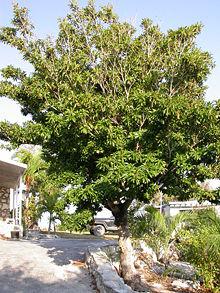
Sapodilla is a long lived, evergreen tree. Sapodilla grows to 3-4 m tall and is resistant to wind. The bark of the tree is rich in white, gummy latex. The green and glossy leaves appear alternately and are elliptical in shape. The flowers are white in colour and have a bell shape. The fruit is large with an elliptical shape and resembles a potato and has around 2-5 seeds inside. The flesh of the fruit has a pale yellow to brown colour with a grainy texture that is similar to a ripened pear. The trees survive in warm, and tropical environments and they die quickly if the temperature goes below freezing. After germination, this tree takes around 5-8 years to bear a fruit. The fruits are produced twice in a year but they flowers the whole year round.
Nelli (Indian Gooseberry)
Common Name: Nelli (Indian Gooseberry)
Scientific Name: Phyllanthus emblica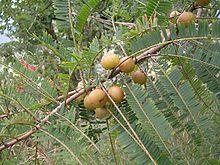
Indian Gooseberry, is largely cultivated for its berries called Nellikka, because the fresh and dried fruits are used in Ayurvedic medicine. The taste of this fruit is a mixture of sour, bitter and astringent. The sour taste changes to sweet if we drink water along with it. All parts such as the fruit, its seeds, leaves, root, bark as well as the leaves have various medicinal properties and hence used in preparing ayurvedic medicines. It can be used to balance vata because of its sour taste and kapha as a result of its astringent taste and drying action. It is used as a rasayana for curing various health issues such as digestion problems, constipation, fever, blood purification, cough, asthma etc. This is a main ingredient to prepare the herbal rasayana called Chyavanaprash. The fruit is consumed as such or is used to prepare pickles.
Njaval / Njaara (Black Plum)
Common Name: Njaval / Njaara (Black Plum)
Scientific Name: Syszygium jambolanum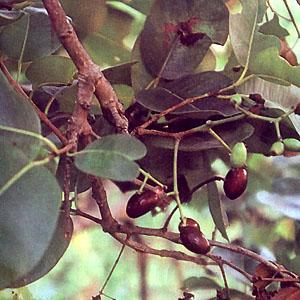
The fruit is known for its sweet, sour and astringent flavor. It is a large evergreen tree with white fragrant flowers and black fruit with pink juicy pulp. This fast growing tree lives for more than 100 years. Its dense leaves provide shade and can be grown for its ornamental value. The wood is strong and is water resistant. Because of this it is used in railway sleepers and to install motors in wells. This tree starts to flower in the months March to April. The fruits begin to develop by May or June and looks like large berries. The fruit is green and changes to a pink to shining black colour when it matures. A variant of this tree has a white coloured fruit. The seed has medicinal values and is used in ayurveda to control diseases like diabetes and also for digestive ailments. The leaves and bark are also useful for controlling blood pressure. Wine and vinegar are also made from the fruit. It is a high source of vitamin A and vitamin C.
Kodukappuli (Manila Tamarind)
Common Name: Kodukappuli (Manila Tamarind)
Scientific Name: Pithecellobium dulce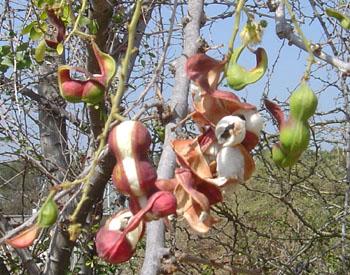
The well known adage ‘An apple a day keeps a doctor away’ may be modified thus ‘A kodukappuli a day may indeed keep pain away’. This is an evergreen tree which grows very fast and has a crooked trunk with small branches that arise from the base of the leaves. The flowers are greenish white in colour, fragrant and it produces a pod with an edible pulp. The liquid obtained by boiling the bark can be used for curing frequent bowel movement. Decoctions of leaves are used for digestion problems and used as abortifacient. Flowering occurs from January to March and the fruit ripens from April to July. The hard timber is used for various purposes such as for construction, packing cases, making fences, cart building and agricultural tools.
Sheema nelli (Star gooseberry)
Common Name: Sheema nelli (Star gooseberry)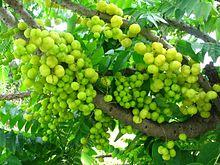
Scientific Name: Phyllanthus acidus
Indigenous fruit trees like Sheema nelli that does not require much care and attention is a boon to every household. The tree often bears fruit twice a year in, first during April to May and then during August-September. Star gooseberry fruit is known to contain extremely high amounts of natural vitamin C, an antioxidant with potent anti-ageing properties. It has only one seed in each fruit. The flowers are male, female or hermaphrodite and are small, pinkish in colour and appear in clusters.
Kadaplavu /Seemaplavu (Bread fruit)
Common Name: Kadaplavu /Seemaplavu (Bread fruit)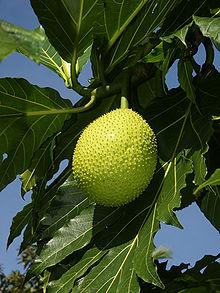
Scientific Name: Artocarpus altilis
Bread fruit is a high yielding food plant and is consumed baked, boiled, fried, steamed or roasted like potatoes. It is grown in most of the homesteads of Kerala. Breadfruit trees grow to a height of 20 m. The leaves are large which are deeply cut into pinnate lobes.
Elimbi / Pulinchi (Cucumber tree)
Common Name: Elimbi / Pulinchi (Cucumber tree)
Scientific Name: Averrhoa carambola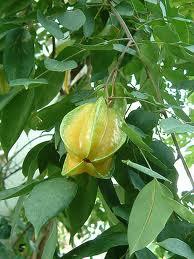
This tree grows well when there is evenly distributed rainfall throughout the year. The flowers and fruits arise from the trunk as well as from the branches. The unripe fruit is bright green and crispy and changes yellowish when it ripens. The flesh is green in colour and acidic and can be consumed as raw itself with salt. The skin of the fruit is glossy and thin. They are also used for making pickles. The leaves are used in the treatment of venereal disease. The decoction of the leaf can be taken as a medicine for rectal inflammation. They are also effective against coughs.
Puli (Tamarind)
Common Name: Puli (Tamarind)
Scientific Name: Tamarindus indica 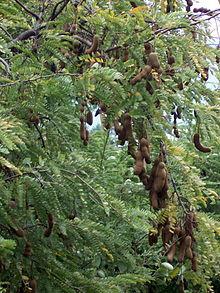
Tamarind, a widely cultivated or naturally grown perennial tree are mainly used as a spice. The sour and fruity taste of tamarind makes it a vital spice of most of the culinary items. It is widely used to provide a sweet and tart flavor to savoury dishes. The tamarind pulp is used as condiment in dishes. It also has many medicinal properties. The paste prepared by crushing the leaves is a quick remedy for boils and swellings. The leaves also have a cooling effect and hence used in the treatment of cold and relieves liver congestion, chronic constipation etc. It is also an anti-hemorrhoid. People have a belief that if they stand under the shade of this plant for a long time it may affect their health which may even cause death. The ripe fruit is an appetizer and also used for healing wounds and fractures.
Pera (Guava)
Common Name: Pera (Guava)
Scientific Name: Psidium guajava 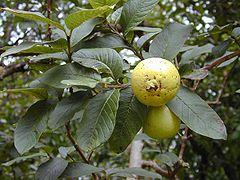
Guava trees are small shrubby evergreen trees, with a lot of strong bony like branches. It is commonly found throughout Kerala and the main variety of guava cultivated and sold here is the apple guava. The fruits are fleshy and have a sweet taste. The fruit is rich in proteins, carbohydrates, calcium, phosphorus, iron, vitamin A, vitamin B3, vitamin B4 etc. Natural propagation is by birds and small animals. Different parts of the tree have medicinal properties. The decoction of the leaves and bark of this tree are sued for treating various ailments such as diarrhea, dysentery, vomiting and sore throats, and also for regulating the menstrual cycles. They are also gargled to relieve oral ulcers and inflamed gums. The crushed leaves when applied on wounds relieve pain.
Reference:
http://www.kerala.me/